
Coco Gauff’s journey through the 2023 tennis season has been nothing short of remarkable, with her impressive wins, prestigious titles, and substantial prize money earnings. Her success on the court and the significant income she has generated have made headlines worldwide. At just 19, Gauff has achieved the status of being the highest-paid female athlete of the year, a feat that places her among a prestigious group of young athletes breaking barriers. However, despite her earnings reaching a notable $22.7 million, Gauff surprisingly remains outside the list of the top 100 highest-paid athletes globally. This unexpected statistic has sparked conversations about the financial landscape of women’s tennis and the challenges female athletes still face in securing equal recognition in sports.
In recent data published about global athlete earnings, Gauff’s financial achievements in 2023 reveal a gap that remains for female tennis players striving to compete with the world’s top-earning athletes across all sports. While her season earnings are significant by WTA standards, they fall short of the $32.5 million threshold necessary to enter the top 100 highest earners globally. Gauff’s success, however, does reflect a positive trend in women’s tennis: an increased interest and financial investment in female players. Her victory at the US Open alone brought her $3 million, one of the highest payouts in tennis, propelling her closer to the ranks of her tennis predecessors. Yet, this sum, combined with her off-court endorsements, was not enough to position her among the world’s most elite earners, where male athletes still dominate.
Despite these earnings, Gauff’s absence from the top 100 highest-paid athletes list serves as a reminder of the historical income disparity between male and female athletes. Even though women’s tennis has made substantial progress thanks to trailblazers like Billie Jean King, who campaigned for prize money equality, the financial rewards for female players are still far from rivaling their male counterparts. Gauff’s $22.7 million earnings in 2023 are undoubtedly impressive and illustrate the commercial potential of young, talented female athletes. However, this figure also reflects the significant gap that remains when comparing her earnings to male athletes in other sports, where individual contracts, sponsorship deals, and prize money totals are substantially higher. In fact, since 2010, only a select few WTA players—such as Serena Williams, Maria Sharapova, Li Na, and Naomi Osaka—have managed to secure spots in the top tier of global sports earnings.
For Gauff, her financial success is not only a personal milestone but also a moment of collective pride for the women’s tennis community. She stands as a new-generation player who has not only elevated her own career but has also shown that female athletes can command high earnings and major sponsorship deals. However, the fact that her impressive income falls outside the top 100 highlights the income disparity that continues to affect even the most talented female athletes. The achievements of legends like Serena Williams and Maria Sharapova, who were once consistent names among the highest-paid athletes, underscore how much effort is needed to maintain financial recognition for female players in the global sports landscape. Both Williams and Sharapova broke barriers with their endorsement deals and prize money earnings, setting a benchmark that Gauff and her contemporaries are striving to reach.
The absence of female tennis players from the current top-earner lists can be attributed to several factors, including the disproportionate sponsorship opportunities and media exposure that male athletes often receive. This trend is seen not only in tennis but across most professional sports. In recent years, Naomi Osaka has been a notable exception, achieving substantial financial success largely due to her sponsorship portfolio and advocacy for social causes, which resonated widely with brands and fans alike. Yet, even Osaka, who remains active, may not consistently reach the financial heights previously attained by Williams and Sharapova as they each revolutionized earnings in women’s tennis.
As Gauff’s career progresses, there is optimism that her earnings will increase, not only through prize money but also with more expansive endorsement deals, particularly as she builds her legacy as a champion. Yet, the current financial reality signals that the tennis world, along with other sports, must continue its efforts to provide more equal opportunities for female athletes. Gauff’s achievements should remind industry stakeholders—sponsors, tournament organizers, and governing bodies alike—of the value that female athletes bring to the sport. The push for greater investment in women’s sports and fairer distribution of sponsorship opportunities remains a crucial step for ensuring that future generations of female athletes can close the earnings gap.
In the meantime, Gauff’s incredible success at such a young age is not to be understated. Her journey to becoming the highest-paid female athlete of 2023 represents a milestone for her career and for women’s tennis. It speaks to the shifting dynamics in the sport, where younger players are taking on the mantle from legends like Williams and Sharapova. While Gauff may not yet be among the top 100 highest-earning athletes, her achievements remind us of the potential for female athletes to rise, both on the court and in the earnings ranks, as the sports world continues to move toward inclusivity and equality.
As the tennis community reflects on Gauff’s breakthrough year, her financial and athletic success serves as both a point of pride and a call to action, encouraging the industry to create a more balanced playing field. If Gauff’s trajectory is any indication, her potential to influence the sport and her off-court earning power will only grow, setting the stage for a new era in which young female athletes can truly rival their male counterparts in financial recognition and respect on the world stage.
Leave a Reply